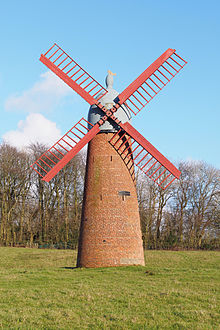 Nashtifan, the ancient city of windmills
Nashtifan, the ancient city of windmillsNo one knows who first acted on the idea of using wind to grind grain.
We do know that there were windmills in Iran by the 7th century. These windmills had a long, vertical drive shaft around which rotated six to twelve rectangular, reed-covered sails. This type of device is called a "panemone" windmill.
The first windmills in Northern Europe date from the 1180s and have a very different design. They are called "post" windmills because of the large upright post on which the mill's main structure, the "buck," is balanced so that the mill can rotate to catch the wind when it comes from different directions. The mill was moved using a tailpole or tiller beam that extended from the rear of the body. The picture below, from a 14th century manuscript, shows a post windmill. The two prone figures to the right make me wonder if this illustrates Chaucer's Miller's Tale, but I might be wrong since the text is in Latin and Chaucer wrote in Middle English.
We do know that there were windmills in Iran by the 7th century. These windmills had a long, vertical drive shaft around which rotated six to twelve rectangular, reed-covered sails. This type of device is called a "panemone" windmill.
The first windmills in Northern Europe date from the 1180s and have a very different design. They are called "post" windmills because of the large upright post on which the mill's main structure, the "buck," is balanced so that the mill can rotate to catch the wind when it comes from different directions. The mill was moved using a tailpole or tiller beam that extended from the rear of the body. The picture below, from a 14th century manuscript, shows a post windmill. The two prone figures to the right make me wonder if this illustrates Chaucer's Miller's Tale, but I might be wrong since the text is in Latin and Chaucer wrote in Middle English.
 Fourteenth century windmill image licensed under Public Domain via Wikimedia Commons
Fourteenth century windmill image licensed under Public Domain via Wikimedia CommonsThis is the kind of windmill that Nathan Marsall had to wrestle into position in my middle grade medieval novel, On Fledgling Wings.
It has widely been suggested that returning Crusaders brought the idea of windmills back to Europe with them. While the timing is right, the huge difference in design suggests that this might not be the case, and that windmills might have been designed independently in Europe and the Middle East.
It has widely been suggested that returning Crusaders brought the idea of windmills back to Europe with them. While the timing is right, the huge difference in design suggests that this might not be the case, and that windmills might have been designed independently in Europe and the Middle East.
How do windmills work? Inside the mill, a shaft attaches to the sails, and called a windshaft for obvious reasons, moves a large wheel. This is called the brake wheel because it has a large wooden friction brake around its outer edge that could slow or stop the milling process. The brake wheel transferres power to a smaller gear at right angles to it. This smaller gear, called the wallower, shares a vertical shaft with a spur wheel, which drive the millstone.

By the 1300s, those who could afford it build tower mills. This type of windmills has a rotating cap that holds just the roof, the sails, the windshaft and the brake wheel while the body of the mill remains stable. They are built from stone or brick, and therefore can be built taller, allowing for larger sails and greater power. However, they were also expensive to produce.
Photo by Francis Franklin (Own work) [CC BY-SA 4.0 (http://creativecommons. org/licenses/by-sa/4.0)], via Wikimedia Commons
Photo by Francis Franklin (Own work) [CC BY-SA 4.0 (http://creativecommons. org/licenses/by-sa/4.0)], via Wikimedia Commons

The Dutch developed a better windmill in the middle of the sixteenth century. Smock mills, named after the dress-like peasants' clothing they resemble, these were large enough to be powerful, yet less expensive to build. (photo by Uberprutser (Own work) [CC BY-SA 3.0 nl (http://creativecommons.org/licenses/by-sa/3.0/nl/deed.en)]
Windmills were a major source of power in Europe from the 1300s to the 1800s. They went out of favor with the development of steam power, and for two hundred years they have languished. However, the trend for organic and non-manufactured foodstuffs has shifted the economics slightly back in their favor once again.





No comments:
Post a Comment